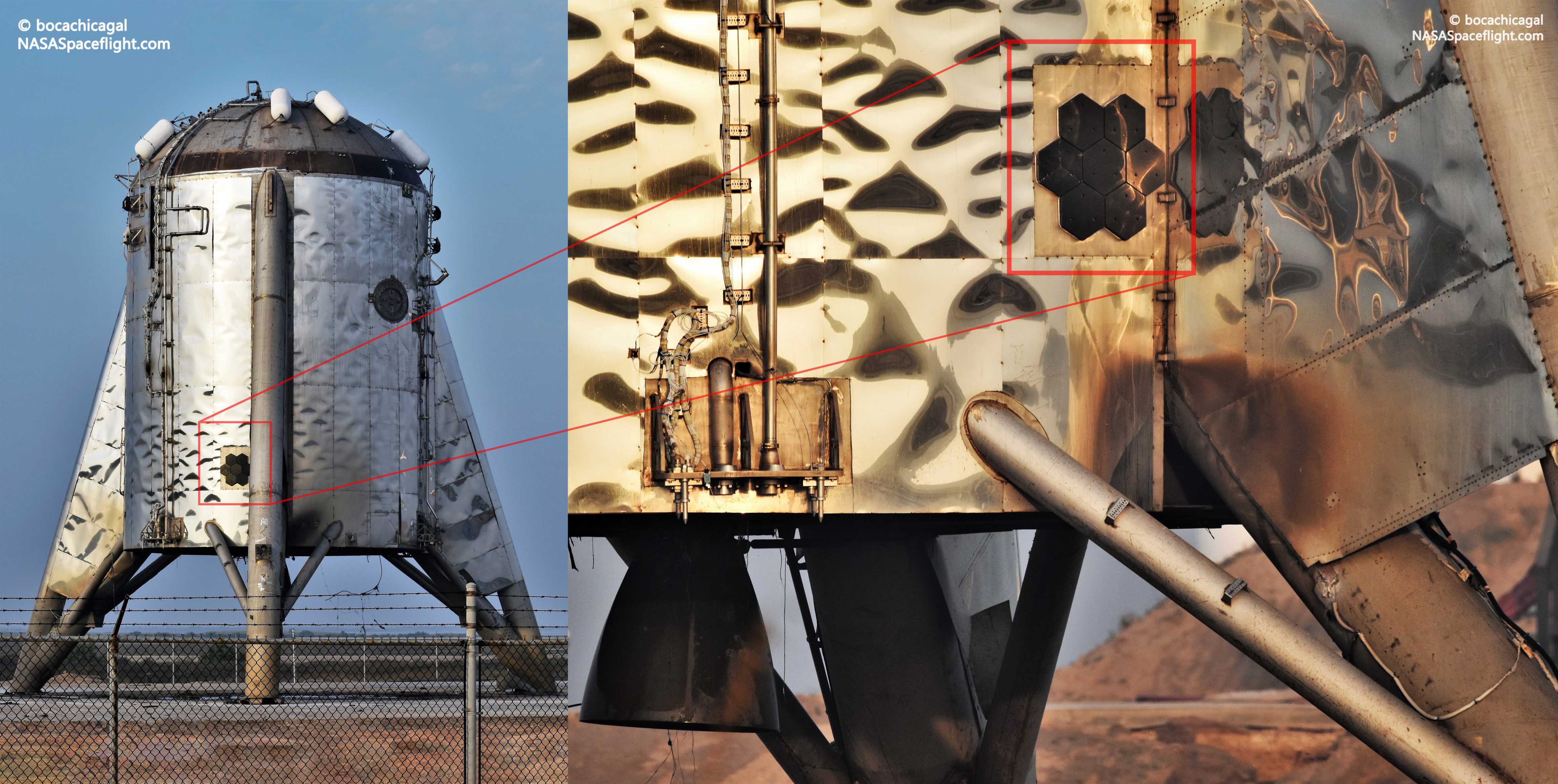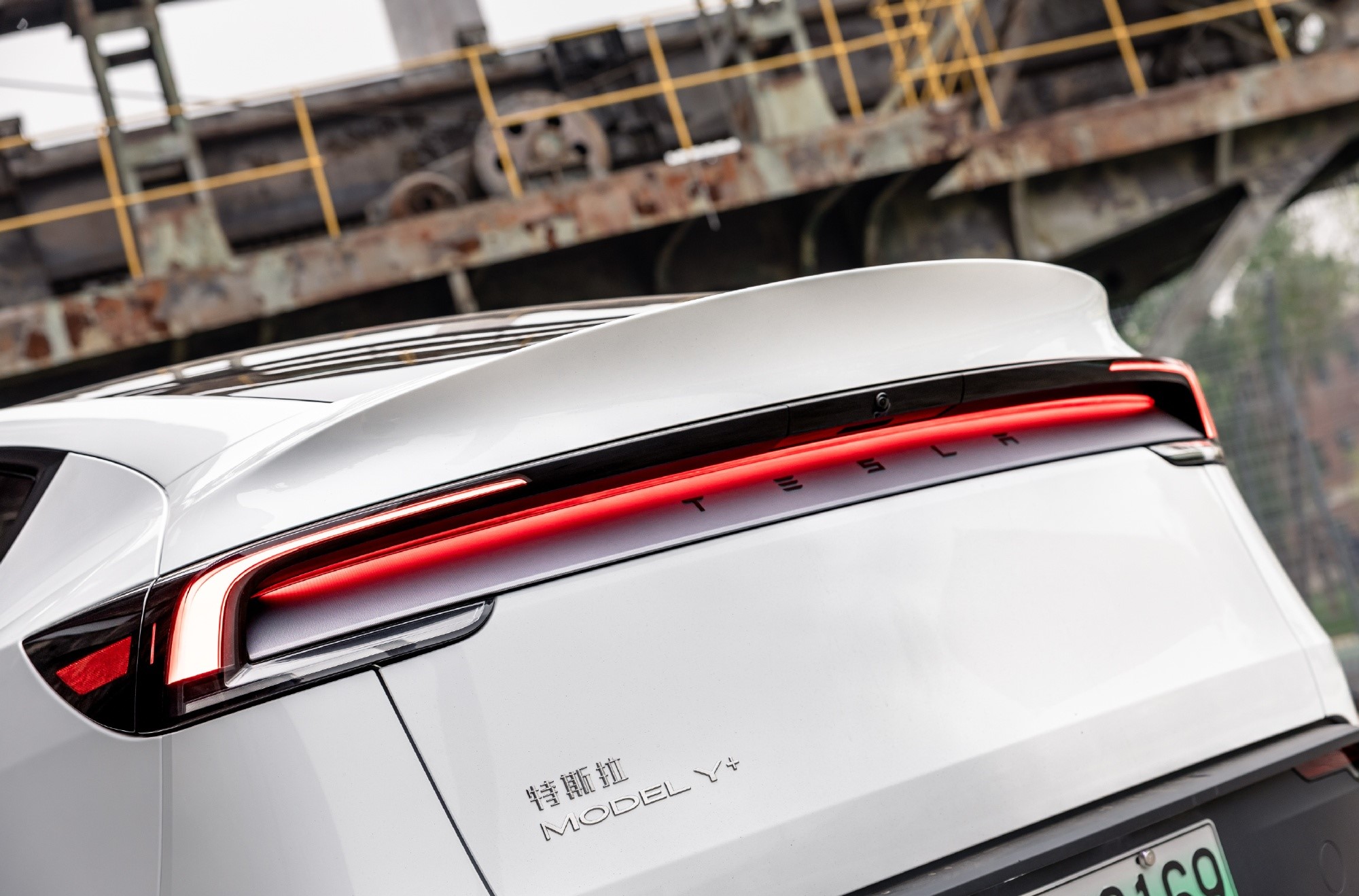

News
SpaceX tests ceramic Starship heat shield tiles on Starhopper’s final flight test
Although it flew under the radar in the heat of the moment, SpaceX’s final Starhopper test flight – completed on August 27th – happened to include an unusual bit of test hardware – eight (give or take) ceramic Starship heat shield tiles.
On the same day that Starhopper lifted off for the last time and completed a 150m (500 ft) hop test in South Texas, SpaceX Cargo Dragon capsule C108 wrapped up its third successful orbital mission, reentering Earth’s atmosphere with a complement of several ceramic Starship heat shield tiles. This marked the first known orbital test of Starship hardware on the same exact day that Starhopper was putting nearly identical tiles through an entirely different kind of flight test.
Tile #8
As pictured above, a group of seven hexagonal tiles appeared on Starhopper’s exterior around August 14th. Those tiles were black (somewhere between matte and glossy), featured indents likely related to manufacturing or mounting, and appeared to be attached to Starhopper by way of a white, marshmallow-esque adhesive. Altogether, each tile bears a striking resemblance to two-thirds of a hexagonal Oreo cookie, arranged in a grid and sort of squished onto Starhopper.

Aside from the seven tiles attached directly to the exterior Starhopper’s liquid methane tank, at least one additional tile was spotted on a small mount structure welded to the bottom of one of the vehicle’s tripod legs. Likely just five or so meters (~15 feet) away from Starhopper’s Raptor engine, that particular tile would have been subjected to intense heating and sound (i.e. thermal and acoustic shock) during the Starship testbed’s final ~60-second flight.
It is a busy morning at the Starship Hopper launch site!
⚙️/⬇️/? : https://t.co/zWfJdm095L pic.twitter.com/KL6azUo4Rd— ?Trevor Mahlmann (@TrevorMahlmann) August 26, 2019
In fact, the Raptor-facing tile may have been put through an even more stressful test than intended, owing to the apparent difficulties Raptor SN06 had during its minute-long performance. Whether the result of shoddy installation and plumbing or an issue with Raptor itself, the engine demonstrated some unusual behavior as it throttled down for Starhopper’s landing, turning its largely transparent exhaust plume into a massive flamethrower.
Raptor or adjacent plumbing also appeared to suffer some kind of leak just before landing, producing significant flames that clearly scorched Starhopper’s rear and destroyed a huge amount of cabling in the area, visible just below the hexagonal tile group. Likely related, several views of the test showed a COPV flying off – clearing having suffered an anomaly that broke it free from Starhopper – around the same time as the vehicle ended its hop with a hard landing.
Tiles on Starhopper?
This does raise the question: why were prototype Starship heat shield tiles attached to Starhopper, a distinctly suborbital prototype that never reached a speed of ~20 m/s (40 mph), let alone orbital velocity? Without actually performing a reentry, what value could be derived? Taken alongside the almost-simultaneous orbital reentry test of four separate Cargo Dragon-shaped tile prototypes, the likely explanation is actually pretty simple and serves as an excellent example of SpaceX’s agile approach to aerospace development.
The three separate tile locations (Starhopper’s tank and leg and Cargo Dragon’s heat shield) all delivered extremely unique test conditions to their respective ceramic tile prototypes. Attached directly to a cryogenic fuel tank, Starhopper’s seven-tile set was almost certainly meant to test methods of mounting a heat shield on a stainless steel tank. Those tiles went through several thermal cycles from propellant loading, spent weeks unprotected in hellish South Texas heat and humidity, and suffered through the shock of flight and a hard landing.
The lone Raptor-adjacent tile was subjected to heating from a live engine just a dozen or so feet away, along with all the brutal acoustic stresses associated with it, perhaps including an unintended fire during anomalous engine performance. Cargo Dragon C108’s four ceramic tiles were far closer to a full-fidelity test, although they were shaped for and attached to the spacecraft in a manner that minimized their one-to-one relevance to Starship’s likely shield design. Regardless of the level of the test’s fidelity, they still managed to survive a true-to-life orbital reentry with nothing more than some soot stains from Dragon’s normal PICA-X shield material.
In short, SpaceX (hopefully successfully) demonstrated a large number of Starship’s ceramic tile design requirements before an actual flight-capable Mk1 or Mk2 Starship is ready for comparable testing. Of course, the most important tests will involve a combination of all Starship-relevant conditions (Raptor engines, cryogenic tank-wall mounting, hexagonal tiles, weeks spent in space, orbital reentry, etc.) for a full-fidelity reentry campaign with an actual Starship prototype. SpaceX CEO Elon Musk says those tests could begin very soon – as early as October 2019 – and the suite of piecemeal Cargo Dragon and Starhopper tests that prototype tiles have already completed will undoubtedly grease the wheels towards that ambitious goal.
Check out Teslarati’s Marketplace! We offer Tesla accessories, including for the Tesla Cybertruck and Tesla Model 3.
News
Tesla opens massive solar Supercharger station in California
The Supercharger opened to customers ahead of Fourth of July weekend, while Tesla continues phase two of construction on the site.

Tesla has officially launched the first several Supercharging posts at a massive station in California, notably including solar canopies and grid-scale batteries to offer completely renewable charging.
Last week, Tesla announced on X that it opened the first 84 Supercharger stalls of a planned 168-stall station in Lost Hills, California. Additionally, the massive Supercharger project features 11MW of solar canopies and 10 Megapack batteries for off-grid charging powered entirely by solar energy.
Tesla completed the first phase of the project just days ahead of the busy Fourth of July holiday weekend, adding that initial construction took just eight months. In addition to the remaining charging stalls, Tesla says it’s building a set of lounge areas, renderings of which can be seen below alongside current photos of the site.
Notably, the site also includes V4 charging posts for the company’s latest available charging speeds, and it’s located near the busy junction between I-5 and Highway 46 in Kern County.
“Thank you [Kern County] and [PG&E] for collaboration and approvals,” Tesla wrote in a follow-up post.

Credit: Tesla Charging | X

Credit: Tesla Charging | X

Credit: Tesla Charging | X

Credit: Tesla Charging | X
Tesla Supercharger Maps for North America, Europe, and Asia pic.twitter.com/0U5r0XRPyo
— TESLARATI (@Teslarati) July 2, 2025
READ MORE ON TESLA SUPERCHARGERS: Tesla launches ultra-fast V4 Superchargers in China for the first time
Testing at the LA Diner, plus Musk update on potential Tesla solar Gigafactory
The huge Tesla Supercharger station completed phase one of construction fairly quickly, especially given how long Tesla has been working on its unique Los Angeles diner, drive-in, and Supercharger location. Still, the company was seen performing some testing at the nearly-completed charging station earlier this month, and will reportedly be holding a job fair.
Elon Musk also responded on Monday morning to a post on X, suggesting that Tesla is “thinking about” building a U.S.-based solar Gigafactory in order to help support increased power needs with AI growth, and to bolster domestic solar production.
Tesla is building a new UFO-inspired Supercharger in the heart of Alien country
News
Tesla driver walks away from major accident with minor injuries
The driver sustained only minor injuries, and the exact cause of the crash remains under investigation.

The driver of a Tesla Model Y survived and walked away from a harrowing accident on Monday in California, only sustaining minor injuries despite the vehicle being impaled by a guardrail.
On Monday morning around 4:34 a.m., the Los Banos division of the California Highway Patrol (CHP) responded to the accident on I-5 near Panoche Road, involving a 23-year-old in a Tesla Model Y. According to a post on social media, the driver veered off the road for unknown reasons in the northbound lane, before crashing directly into the guardrail and impaling the vehicle.
You can read the full message and photos from Los Banos CHP below, as were shared in a Facebook post on Monday afternoon.
This morning a Tesla model y was traveling in the #1 northbound lane of I-5 north of Panoche Rd. For unknown reasons driver allowed V-1 to veer off the roadway, travel through a dirt center divide, and crashed into the fixed metal guardrail. Lucky for the driver he only sustained minor injuries and was able to walk away. Driving a vehicle requires 100% attention to the road. Avoid distractions and focus on driving.

Credit: CHP Los Banos (via Facebook)

Credit: CHP Los Banos (via Facebook)

Credit: CHP Los Banos (via Facebook)
In a statement to SFGate, CHP officer Myles Anderson said that the driver only sustained minor injuries, while no arrests are made and drugs and alcohol are not suspected to have been involved. The report also notes that Tesla’s “cruise control and lane assistance features” were activated, according to Anderson. However, it’s not entirely clear if this is referring to Supervised Full Self-Driving (FSD), or to the cruise control and lane assist features baked into Autopilot.
At the time of writing, CHP has not yet responded to Teslarati’s request for clarification and additional details on the matter.
Tesla Crash Safety Ratings across its lineup: pic.twitter.com/ny30R7ceji
— TESLARATI (@Teslarati) July 1, 2025
READ MORE ON TESLA SAFETY: Tesla rolls out crucial new safety feature aimed at saving children
The news comes after Tesla has touted its vehicles as incredibly safe for many years. In December, for example, the company highlighted receiving top safety scores from regulators on four different continents throughout the world, including from the National Highway Traffic Safety Administration (NHTSA) and the Insurance Institute of Highway Safety (IIHS) in the U.S.
Tesla has also listed the goal of making its vehicles the safest on the road throughout the years, both in the overall design of its vehicles and in its Autopilot and Full Self-Driving (FSD) programs.
Tesla Model 3 ranks as the safest new car in Europe for 2025, per Euro NCAP tests
Investor's Corner
Cantor Fitzgerald maintains Tesla (TSLA) ‘Overweight’ rating amid Q2 2025 deliveries
Cantor Fitzgerald is holding firm on its bullish stance for the electric vehicle maker.

Cantor Fitzgerald is holding firm on its bullish stance for Tesla (NASDAQ: TSLA), reiterating its “Overweight” rating and $355 price target amidst the company’s release of its Q2 2025 vehicle delivery and production report.
Tesla delivered 384,122 vehicles in Q2 2025, falling below last year’s Q2 figure of 443,956 units. Despite softer demand in some countries in Europe and ongoing controversies surrounding CEO Elon Musk, the firm maintained its view that Tesla is a long-term growth story in the EV sector.
Tesla’s Q2 results
Among the 384,122 vehicles that Tesla delivered in the second quarter, 373,728 were Model 3 and Model Y. The remaining 10,394 units were attributed to the Model S, Model X, and Cybertruck. Production was largely flat year-over-year at 410,244 units.
In the energy division, Tesla deployed 9.6 GWh of energy storage in Q2, which was above last year’s 9.4 GWh. Overall, Tesla continues to hold a strong position with $95.7 billion in trailing twelve-month revenue and a 17.7% gross margin, as noted in a report from Investing.com.
Tesla’s stock is still volatile
Tesla’s market cap fell to $941 billion on Monday amid volatility that was likely caused in no small part by CEO Elon Musk’s political posts on X over the weekend. Musk has announced that he is forming the America Party to serve as a third option for voters in the United States, a decision that has earned the ire of U.S. President Donald Trump.
Despite Musk’s controversial nature, some analysts remain bullish on TSLA stock. Apart from Cantor Fitzgerald, Canaccord Genuity also reiterated its “Buy” rating on Tesla shares, with the firm highlighting the company’s positive Q2 vehicle deliveries, which exceeded its expectations by 24,000 units. Cannacord also noted that Tesla remains strong in several markets despite its year-over-year decline in deliveries.
-

 Elon Musk1 week ago
Elon Musk1 week agoTesla investors will be shocked by Jim Cramer’s latest assessment
-

 News2 weeks ago
News2 weeks agoTesla Robotaxi’s biggest challenge seems to be this one thing
-

 News2 weeks ago
News2 weeks agoWatch the first true Tesla Robotaxi intervention by safety monitor
-

 Elon Musk1 week ago
Elon Musk1 week agoA Tesla just delivered itself to a customer autonomously, Elon Musk confirms
-

 News2 weeks ago
News2 weeks agoTesla Robotaxi rollout proves that Elon Musk still delivers, even if it’s late
-

 Elon Musk2 weeks ago
Elon Musk2 weeks agoxAI welcomes Memphis pollution results, environmental groups push back
-

 Elon Musk2 weeks ago
Elon Musk2 weeks agoElon Musk commends Tesla team on successful Robotaxi launch
-

 Elon Musk2 weeks ago
Elon Musk2 weeks agoElon Musk confirms Tesla Optimus V3 already uses Grok voice AI


















